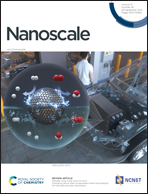Bidirectional doping of two-dimensional thin-layer transition metal dichalcogenides using soft ammonia plasma†
Abstract
Because of suitable band gap and high mobility, two-dimensional transition metal dichalcogenide (TMD) materials are promising in future microelectronic devices. However, controllable p-type and n-type doping of TMDs is still a challenge. Herein, we develop a soft plasma doping concept and demonstrate both n-type and p-type doping for TMDs including MoS2 and WS2 through adjusting the plasma working parameters. In particular, p-type doping of MoS2 can be realized when the radio frequency (RF) power is relatively small and the processing time is short: the off-state current increases from ∼10−10 A to ∼10−8 A, the threshold voltage is positively shifted from −26.2 V to 8.3 V, and the mobility increases from 7.05 cm2 V−1 s−1 to 16.52 cm2 V−1 s−1. Under a relatively large RF power and long processing time, n-type doping was realized for MoS2: the threshold voltage was negatively shifted from 6.8 V to −13.3 V and the mobility is reduced from 10.32 cm2 V−1 s−1 to 3.2 cm2 V−1 s−1. For the former, suitable plasma treatment can promote the substitution of N elements for S vacancies and lead to p-type doping, thus reducing the defect density and increasing the mobility value. For the latter, due to excessive plasma treatment, more S vacancies will be produced, leading to heavier n-type doping as well as a decrease in mobility. We confirm the results by systematically analyzing the optical, compositional, thickness and structural characteristics of the samples before and after such soft plasma treatments via Raman, photoluminescence (PL), atomic force microscopy (AFM), X-ray photoelectron spectroscopy (XPS) and transmission electron microscopy (TEM) measurements. Due to its nondestructive and expandable nature and compatibility with the current microelectronics industry, this potentially generic method may be used as a reliable technology for the development of diverse and functional TMD-based devices.



 Please wait while we load your content...
Please wait while we load your content...